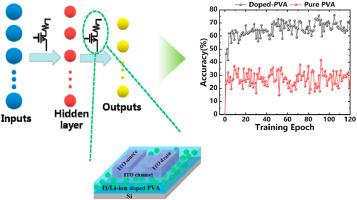Organic Electronics ( IF 2.7 ) Pub Date : 2020-11-26 , DOI: 10.1016/j.orgel.2020.106019 Jinsong Huang , Jinwei Chen , Rengjian Yu , Yilun Zhou , Qian Yang , Enlong Li , Qizhen Chen , Huipeng Chen , Tailiang Guo

|
Biodegradable and environmentally friendly artificial synapse devices are essential for the future development of neuromorphic computing. The emergence of synaptic transistors based on biocompatible polymer materials provides an ideal approach to achieve green electronics. However, modulating the synaptic properties in a wide range in a fixed biocompatible synaptic transistor is still challengeable, while it is vitally important for improving the adaptability of the synaptic device to achieve neuro-prosthetics in the future. Here, we reported the regulation of the synaptic behavior of biocompatible synaptic transistor through ion-doping, which allows to adjusting the response of the synaptic device according to a specific function. The ions doped into the insulating layer strengthen the formation of electric double layers (EDLs), which enables a remarkable regulation effect on post-synaptic current. Moreover, basic synaptic properties, including excitatory/inhibitory post-synaptic current (EPCS/IPSC), paired-pulse facilitation/depression (PPF/PPD), short-term/long-term memory (STM/LTM) are successfully demonstrated. In addition, high-pass and low-pass filtering functions are also implemented in a single synaptic device, indicating that the synapse attenuation can be effectively transformed according to the needs of the function. More importantly, this is the first work to demonstrate that the accuracy of pattern recognition of synaptic transistors, an important indicator of neuromorphic calculations, can be significantly improved via ion doping (as high as 75.96% relative to undoped devices of 41.68%). Our research provides a feasible strategy for precisely controlling synaptic behaviors, which has a profound impact on improving the adaptability of artificial synaptic devices in the field of neuromorphic computing.
中文翻译:

通过离子掺杂调节生物相容性突触晶体管的突触行为
可生物降解且环保的人工突触设备对于神经形态计算的未来发展至关重要。基于生物相容性聚合物材料的突触晶体管的出现为实现绿色电子学提供了理想的方法。然而,在固定的生物相容性突触晶体管中广泛地调节突触特性仍然具有挑战性,而对于提高突触装置的适应性以实现未来的神经修复至关重要。在这里,我们报道了通过离子掺杂对生物相容性突触晶体管的突触行为的调节,该调节允许根据特定功能调节突触装置的响应。掺杂到绝缘层中的离子加强了双电层(EDL)的形成,这对突触后电流具有显着的调节作用。此外,成功地证明了基本的突触特性,包括兴奋性/抑制性突触后电流(EPCS / IPSC),成对脉冲促进/抑制(PPF / PPD),短期/长期记忆(STM / LTM)。另外,在单个突触设备中还实现了高通和低通滤波功能,这表明可以根据功能的需要有效地转换突触衰减。更重要的是,这是首次证明通过离子掺杂可以显着提高突触晶体管模式识别的准确性,突触晶体管是神经形态计算的重要指标,相对于未掺杂器件的41.68%,其准确度可高达75.96%。











































 京公网安备 11010802027423号
京公网安备 11010802027423号